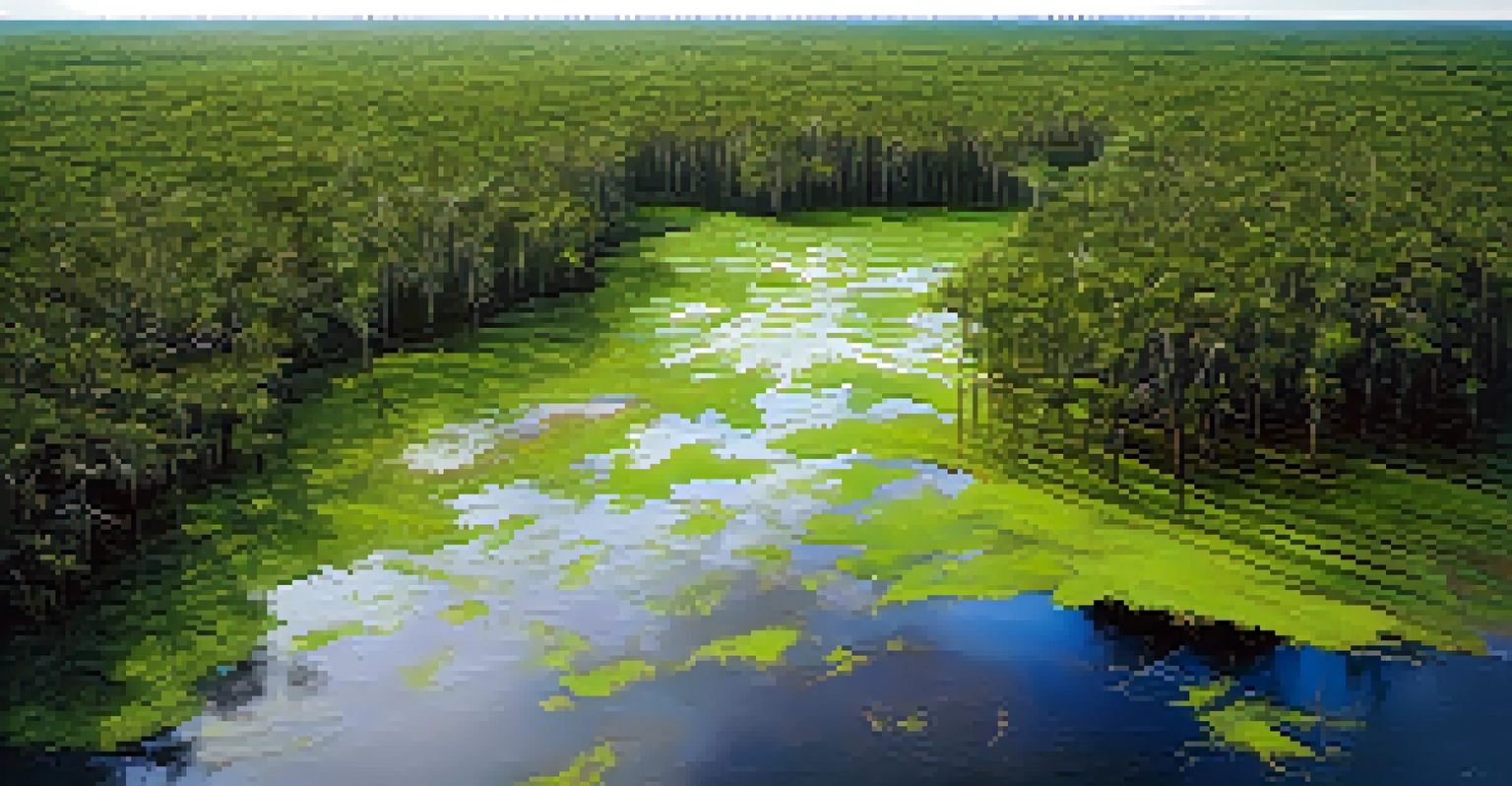The Role of Hurricanes in Shaping Florida's Climate Landscape

Understanding Florida's Unique Climate Conditions
Florida's climate is often described as subtropical, characterized by hot, humid summers and mild winters. This unique climate is influenced by its geographical location, surrounded by warm ocean waters. The state is prone to hurricanes due to its position near the tropics, making it a hotbed for tropical storms. These conditions create a dynamic interplay between temperature, humidity, and storm activity that shapes Florida's environment.
The greatest danger in times of turbulence is not the turbulence; it is to act with yesterday's logic.
The warm waters of the Gulf of Mexico and the Atlantic Ocean play a crucial role in hurricane formation. When warm, moist air rises from these waters, it creates a vacuum that draws in more air, leading to the development of storms. As these hurricanes make landfall, their impact can drastically alter the local climate, sometimes leading to increased rainfall or changes in temperature patterns. Understanding these interactions helps us appreciate the complexity of Florida's climate.
Moreover, Florida's flat terrain and extensive coastline mean that hurricanes can affect large areas, creating widespread changes. Areas that might typically experience dry conditions can suddenly face flooding after a hurricane. These shifts not only affect immediate weather patterns but can also have long-lasting effects on Florida's ecosystems and agricultural practices.
The Formation and Lifecycle of Hurricanes
Hurricanes begin as tropical depressions, which can quickly escalate into powerful storms under the right conditions. The lifecycle of a hurricane involves several stages, including tropical storm and hurricane classifications, based on wind speed. The process of intensification is influenced by sea surface temperatures, atmospheric conditions, and wind shear. Understanding these stages helps us predict and prepare for the potential impacts of these storms.

During their lifecycle, hurricanes can undergo rapid intensification, where they strengthen significantly within a short period. This phenomenon can catch communities off guard, leading to a lack of preparedness. Meteorologists use satellite imagery and data modeling to track these changes, providing critical information for timely warnings. Such insights are vital for minimizing damage and ensuring public safety.
Florida's Climate Fuels Hurricane Activity
The state's subtropical climate, influenced by warm ocean waters, creates conditions conducive to hurricane formation and impacts local weather patterns.
Once a hurricane makes landfall, it begins to weaken, but not without leaving a mark. The transition from a powerful storm to a remnant low can still bring heavy rainfall and strong winds, affecting the climate even after the hurricane has passed. The remnants of these storms can lead to prolonged periods of rain, contributing to flooding and changes in local weather patterns.
Hurricanes as Agents of Change in Ecosystems
Hurricanes can act as natural agents of change, reshaping Florida's ecosystems in both beneficial and detrimental ways. For instance, the strong winds and heavy rains can uproot trees, creating openings in forests that allow sunlight to reach the forest floor. This process can stimulate new growth and support diverse plant species. In wetlands, hurricanes can redistribute sediments, which is essential for maintaining the health of these ecosystems.
Nature does not hurry, yet everything is accomplished.
However, the devastation caused by hurricanes can also lead to significant ecological challenges. Coastal habitats, such as mangroves and coral reefs, often suffer severe damage, impacting the wildlife that depends on them. The loss of these critical habitats can disrupt food chains and reduce biodiversity. Understanding the balance between destruction and renewal is key to managing Florida's unique ecosystems.
After a hurricane, the landscape may take years to recover fully, but nature often finds a way to rebuild. Environmentalists and researchers study the aftermath to understand how ecosystems respond and adapt to such disturbances. This knowledge is vital for conservation efforts, especially as climate change increases the frequency and intensity of hurricanes.
The Economic Impact of Hurricanes on Florida
Hurricanes significantly impact Florida's economy, particularly in tourism, agriculture, and real estate. The tourism industry, which is a major economic driver, often experiences a sharp decline following a hurricane. Many tourists cancel their plans due to safety concerns and the potential for infrastructure damage. This shift can lead to substantial revenue losses for local businesses that rely on seasonal visitors.
Agriculture is another sector that feels the brunt of hurricane impacts, with crop damage and livestock loss posing significant challenges. Florida is a major producer of citrus and other crops, and hurricanes can devastate these fields, leading to long-term economic repercussions for farmers. The financial strain can extend beyond the immediate aftermath, affecting food supply and prices in the region.
Hurricanes Shape Ecosystems and Economy
While hurricanes can rejuvenate ecosystems, they also lead to significant economic challenges, particularly in tourism and agriculture.
On the real estate front, hurricanes can lead to fluctuating property values and insurance costs. Homes in hurricane-prone areas may face higher premiums, making them less attractive to potential buyers. However, the rebuilding process often stimulates local economies, providing jobs and revitalizing communities. Understanding the economic cycles related to hurricanes helps stakeholders make informed decisions.
Hurricane Preparedness and Community Resilience
Preparation is key when it comes to hurricanes, and Florida has implemented various measures to enhance community resilience. Local governments often conduct drills and provide resources to educate residents about emergency plans and evacuation routes. These efforts aim to ensure that individuals and families are ready to respond effectively when storms approach. Being prepared can significantly reduce the risks associated with hurricane impacts.
Community resilience involves not only individual preparedness but also the strength of local infrastructure. Investments in flood defenses, building codes, and emergency services can mitigate damage and expedite recovery. After a hurricane, communities that are better prepared tend to bounce back more quickly, illustrating the importance of proactive measures. Collaboration between local governments and residents is vital for building a resilient future.
Moreover, community engagement plays a crucial role in hurricane preparedness. Local organizations often host workshops and provide resources for vulnerable populations, ensuring everyone has access to vital information. This grassroots approach fosters a sense of unity and shared responsibility, empowering residents to take charge of their safety in the face of unpredictable storms.
The Role of Technology in Hurricane Forecasting
Advancements in technology have revolutionized hurricane forecasting and tracking, saving lives and minimizing damage. Meteorological satellites provide real-time data on storm formation and movement, allowing for timely alerts. This technology enables meteorologists to analyze weather patterns and predict hurricane paths with greater accuracy. The ability to anticipate a storm's trajectory is crucial for effective evacuation planning and resource allocation.
In addition to satellites, computer modeling plays a significant role in understanding hurricane behavior. These models simulate various scenarios based on current data, helping forecasters predict potential impacts. As computing power continues to grow, so does the accuracy of these models, leading to more reliable forecasts. This progress is vital as climate change alters storm patterns and intensities.
Technology Enhances Hurricane Preparedness
Advancements in forecasting technology and community engagement improve residents' ability to prepare for and respond to hurricanes.
Mobile applications and social media have also become essential tools for disseminating information quickly. Local authorities can share real-time updates, safety tips, and evacuation orders, ensuring residents remain informed. The integration of technology into hurricane preparedness and response has transformed how communities interact with these natural phenomena, making it easier to navigate the uncertainties of storm season.
Looking Ahead: Climate Change and Future Hurricanes
As climate change continues to impact global weather patterns, the frequency and intensity of hurricanes are expected to rise. Warmer ocean temperatures can fuel stronger storms, leading to more destructive hurricanes hitting Florida. This reality poses significant challenges for residents, businesses, and ecosystems. Understanding these trends is crucial for developing effective adaptation strategies.
Researchers are actively studying the relationship between climate change and hurricane behavior to provide insights into future risks. By analyzing historical data and current trends, scientists aim to forecast potential changes in storm patterns. This knowledge can inform public policy and disaster preparedness efforts, ensuring communities are equipped to handle future challenges.

Moreover, addressing climate change requires a collective effort at local, national, and global levels. Community initiatives focused on sustainability, conservation, and reducing carbon footprints play a vital role in mitigating the impacts of climate change. By taking proactive steps, Florida can not only prepare for future hurricanes but also contribute to a healthier planet for generations to come.